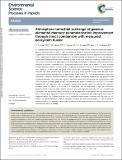Atmosphere-terrestrial exchange of gaseous elemental mercury: parameterization improvement through direct comparison with measured ecosystem fluxes
Author(s)
Khan, T. R.; Obrist, D.; Agnan, Y.; Selin, Noelle E; Perlinger, J. A.
DownloadAccepted version (915.0Kb)
Terms of use
Metadata
Show full item recordAbstract
To simulate global mercury (Hg) dynamics in chemical transport models (CTMs), surface-atmosphere exchange of gaseous elemental mercury, Hg[superscript 0], is often parameterized based on resistance-based dry deposition schemes coupled with a re-emission function, mainly from soils. Despite extensive use of this approach, direct evaluations of this implementation against field observations of net Hg[superscript 0] exchange are lacking. In this study, we evaluate an existing net exchange parameterization (referred to here as the base model) by comparing modeled fluxes of Hg[superscript 0] to fluxes measured in the field using micrometeorological techniques. Comparisons were performed in two terrestrial ecosystems: a grassland site in Switzerland and an Arctic tundra site in Alaska, U.S., each including summer and winter seasons. The base model included the dry deposition and soil re-emission parameterizations from Zhang et al. (2003) and the global CTM GEOS-Chem, respectively. Comparisons of modeled and measured Hg[superscript 0] fluxes showed large discrepancies, particularly in the summer months when the base model overestimated daytime net deposition by approximately 9 and 2 ng mHg[superscript -2] hHg[superscript −1] at the grassland and tundra sites, respectively. In addition, the base model was unable to capture a measured nighttime net Hg[superscript 0] deposition and wintertime deposition. We conducted a series of sensitivity analyses and recommend that Hg simulations using CTMs: (i) reduce stomatal uptake of Hg0 over grassland and tundra in models by a factor 5–7; (ii) increase nighttime net Hg[superscript 0] deposition, e.g., by increasing ground and cuticular uptake by reducing the respective resistance terms by factors of 3–4 and 2–4, respectively; and (iii) implement a new soil re-emission parameterization to produce larger daytime emissions and lower nighttime emissions. We also compared leaf Hg[superscript 0] uptake over the growing season estimated by the dry deposition model against foliar Hg measurements, which revealed good agreement with the measured leaf Hg concentrations after adjusting the base model as suggested above. We conclude that the use of resistance-based models combined with the new soil re-emission flux parameterization is able to reproduce observed diel and seasonal patterns of Hg[superscript 0] exchange in these ecosystems. This approach can be used to improve model parameterizations for other ecosystems if flux measurements become available.
Date issued
2019-09Department
Massachusetts Institute of Technology. Institute for Data, Systems, and SocietyJournal
Environmental science: Processes & Impacts
Publisher
Royal Society of Chemistry (RSC)
Citation
Khan, T. R., et al. "Atmosphere-terrestrial exchange of gaseous elemental mercury: parameterization improvement through direct comparison with measured ecosystem fluxes." Environmental science: Processes & Impacts 21, 10 (October 2019):1699-1712 © 2019 The Royal Society of Chemistry
Version: Author's final manuscript
ISSN
2050-7887
2050-7895